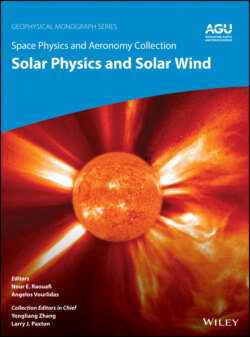Читать книгу Space Physics and Aeronomy, Solar Physics and Solar Wind - Группа авторов - Страница 22
1.4.2. Alfvén Waves in the Fast and Slow Winds
ОглавлениеAt large scales, one of the most distinctive feature is the high degree of correlation between magnetic and velocity fluctuations, suggesting an Alfvénic origin and corresponding to a flux of waves moving away from the Sun (Belcher & Davis, 1971). Even though the spectrum of velocity fluctuations within the inertial range follows a shallower power law, f −3/2, than the one governing magnetic fluctuations (Podesta et al., 2006; C. Salem et al., 2009). Alfvénic fluctuations are ubiquitous in the fast solar wind, where the correlation between velocity and magnetic field is typically very high, especially closer to the Sun. This is not the case in the slow wind, which is more irregular and compressible, and in general it does not display a high level of Alfvénic correlation. However, there are also periods of slow wind that appear highly Alfvénic, suggesting then a common origin as the main fast wind coming from coronal holes (D’Amicis & Bruno, 2015). Consistent with that, all the properties of this Alfvénic slow wind match those of the fast wind, thus reinforcing the idea of a common origin of the plasma (D’Amicis et al., 2018). Interestingly, in situ measurements suggest that a higher fraction of slow solar wind is also Alfvénic closer to the Sun (Stansby et al., 2019); this is an aspect that will benefit from the future explorations of Solar Orbiter and Parker Solar Probe.
Alfvénic streams (fast and slow) always display a 1/f range at large scales (Bavassano, Dobrowolny, Mariani et al., 1982; Denskat & Neubauer, 1982). It has been suggested that these fluctuations originate in the corona (Matthaeus & Goldstein, 1986), could be generated by Alfvén wave reflection in the acceleration region due to strong density gradients (Velli et al., 1989; Verdini et al., 2012), by parametric instability (Chandran, 2018), or be a consequence of a saturation of the wave amplitude (Matteini et al., 2018).
Alfvénic periods in the solar wind are also characterized by a remarkably low plasma and magnetic field compressibility (Matteini et al., 2015). This means that fluctuations in the 1/f range, although large and comparable to the background magnetic field intensity, act mostly like directional changes rather than compressing the field. How this state is achieved is today not fully understood, but it is very well maintained by the plasma during expansion, as confirmed by observations by Ulysses beyond 1 AU. Another consequence of this state is that modulation of the magnetic field also implies (anti‐correlated) local variations of the flow speed. This results in a spiky velocity profile in the fast solar wind (Matteini et al., 2014); the amplitude of the velocity enhancements tracks the Alfvén speed and is then largest close to the Sun. As mentioned earlier, Horbury et al. (2018) have suggested that the Alfvénic spikes observed in fast streams could be signatures of Alfvénic pulses injected by coronal jets surviving in interplanetary space (Karpen et al., 2017; M. A. Roberts et al., 2018). It has been argued that the effect of jets and velocity shears that may develop in the corona could significantly increase the strength of the radial component of the interplanetary magnetic field with radial distance away from the Sun (Lockwood et al., 2009a, 2009b). These kinematic effects could be the source of discrepancy between the open magnetic flux derived from numerical models of the solar corona and the magnetic field measured in situ (Lockwood et al., 2009a).
Below the 1/f range, and at scales smaller than a few hours, a turbulent inertial range is observed in all main fields (magnetic, electric, velocity and density); for example, see the review paper by Alexandrova et al. (2013). In the fast/Alfvénic wind, this corresponds to an almost incompressible MHD cascade, where fluctuations in density are small compared to magnetic and velocity fluctuations. The slow wind typically has a higher level of compressibility, suggesting a mixture of Alfvénic fluctuations and compressible structures, whose weight in the power spectrum also varies as a function of distance. Estimations of the turbulent cascade rate (Coburn et al., 2014; Sorriso‐Valvo et al., 2007) confirm the existence of an energy flux through MHD scales, whose amplitude roughly matches the external energy input needed to explain ion temperature profiles in interplanetary space (Hellinger et al., 2011)
